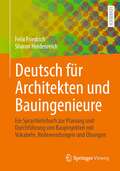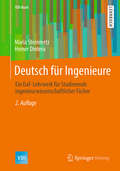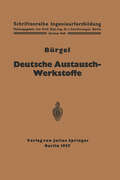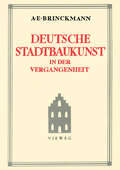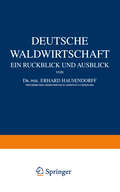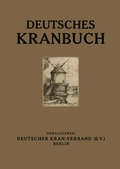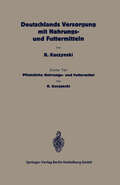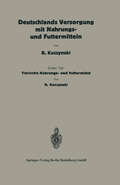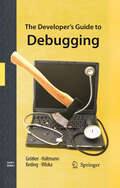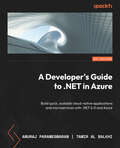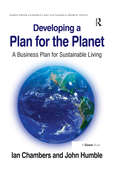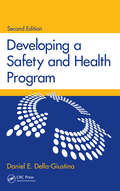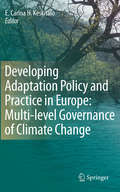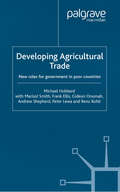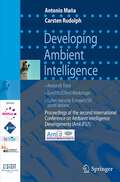- Table View
- List View
Detox Fashion: Waste Water Treatment (Textile Science and Clothing Technology)
by Subramanian Senthilkannan MuthuThis third volume on detox fashion highlights sustainable wastewater treatment methods, as well as techniques used by and the adoption of detox strategies by different brands in the textile sector. These aspects are addressed in three central chapters: Sustainable Wastewater Treatment Technologies; Review of the Utilization of Plant-based Natural Coagulants as Alternatives to Textile Wastewater Treatment; and New Waste Management through Collaborative Business Models for Sustainable Innovation.
Detox Fashion: Case Studies (Textile Science and Clothing Technology)
by Subramanian Senthilkannan MuthuThis fourth volume on detox fashion focuses on case studies, which are essential to showcase how practical applications have been accomplished, and provide an opportunity for others to (learn about and) adopt the best practices, challenges and practical implications. The book consists of three core chapters: Detoxifying the Supply Chain: Slow Production Networks in South-East European Garment Factories; Detoxifying the Luxury and Fashion Industry: The Case of Market-driving Brands; and Detox My Fashion under Mission 2020—Case Studies from Different Brands.
Detox Fashion: Sustainable Chemistry and Wet Processing (Textile Science and Clothing Technology)
by Subramanian Senthilkannan MuthuThis second volume on detox fashion covers five key aspects relevant to the topic sustainable chemistry and wet processes: Sustainable Chemicals: A Model for Practical Substitution; Sustainable Wet Processing; Coloration and Functional Finishing of Cotton with Plant Extracts; Call for an Environmental Impact Assessment of Bio-based Dyeing—an Overview; and Enzymes: Biocatalysts for Cleaning Up the Textile and Apparel Sector. The book also presents interesting solutions at the level of the supply chain with regard to sustainable chemistry and wet processes.
Detoxification of Chemical Warfare Agents: From WWI to Multifunctional Nanocomposite Approaches
by Dimitrios A. Giannakoudakis Teresa J. BandoszThis book presents a detailed history of chemical warfare development during the First World War and discusses design approaches to gas masks and the performance of new filter materials that decontaminate chemical warfare agents (CWA) when applied in the vapor phase. It describes multifunctional nanocomposites containing zinc and zirconium (hydr)oxides, graphite oxide and silver or gold nanoparticles as reactive adsorbents for the degradation of the CWAs vapors. In addition it examines in detail the surface properties that are most important in the mineralization performance.
Deuteride Materials
by Jiping Liu Xiaobo LiuThis is the very first book that offers an up-to-date and comprehensive overview on deuteride. It not only includes the concept, existing forms, key characteristics, but also reviews the preparation and characterization technologies and the latest research developments of deuteride. The special properties such as the nuclear properties, isotropic and neutron effect, poisonousness, radioactivity, volume expansion are systematically discussed to build up the sound understanding of the materials. In particular, this work reviews a number of commercial and scientific uses of the materials including nuclear reactors, NMR spectroscopy and medicines. Researchers and industrial professionals in medicine, chemistry, biochemistry, environmental sciences and defense sciences will benefit from this work.
Deutsch für Architekten und Bauingenieure: Ein Sprachlehrbuch zur Planung und Durchführung von Bauprojekten mit Vokabeln, Redewendungen und Übungen
by Felix Friedrich Sharon HeidenreichEin Sprachlehrbuch, das speziell für Architekten, Bauingenieure und verwandte Berufsgruppen aller Nationalitäten konzipiert ist, die ihre deutsche Kommunikationsfähigkeit im beruflichen Kontext verbessern wollen. Das Buch kann sowohl für das Selbststudium als auch kursbegleitend eingesetzt werden. Nachdem in der 1. Hälfte des Buches viele Grundlagen der Bauwirtschaft behandelt werden, orientiert sich die 2. Hälfte an den Leistungsphasen und der Abwicklung von Beispielprojekten. Pro Kapitel werden Fachvokabular, Redewendungen, Kommunikationsformen und auch Grammatik vermittelt. Übungen und Aufgaben mit Lösungen runden das Werk ab.Nach dem Gemeinsamen europäischen Referenzrahmen (GER) für Sprachen entspricht das Lehrwerk einem Niveau von B2/C1.
Deutsch für Ingenieure: Ein DaF-Lehrwerk für Studierende ingenieurwissenschaftlicher Fächer (VDI-Buch)
by Maria Steinmetz Heiner DinteraDieses DaF-Lehrbuch ist inhaltlich passgenau zugeschnitten für Ingenieurstudenten im In- und Ausland. Es ist ein kombiniertes Lehr- und Arbeitsbuch für Lerner mit Deutschkenntnissen ab A2-Niveau. Es enthält aber auch anspruchsvollere Texte und Übungen bis hin zum Niveau C1. Alle inhaltlichen Themen stammen aus Gebieten, die für angehende Ingenieure elementar und von fachlichem Interesse sind. Bei den Themen und Übungen liegt der Schwerpunkt exakt auf den sprachlichen Merkmalen, die für eine Fachkommunikation in den MINT-Fächern wichtig sind. Hier finden Sie praxisnahe und anschauliche Übungen für die Informationsbeschaffung, -strukturierung und -präsentation, die im ingenieurwissenschaftlichen Bereich benötigt werden. Die aktuelle Auflage enthält ein völlig neues Kapitel zur Physik, weitere hilfreiche Informationen zum Sprachniveau sowie ein neues Grammatikregister am Ende des Buches.
Deutsch für Ingenieure: Ein DaF-Lehrwerk für Studierende ingenieurwissenschaftlicher Fächer (VDI-Buch)
by Maria Steinmetz Heiner DinteraEndlich – hier ist das lang erwartete DaF-Lehrbuch für Ingenieurstudenten im In- und Ausland.Es ist ein kombiniertes Lehr- und Arbeitsbuch für Lerner mit Deutschkenntnissen ab A2-Niveau. Es enthält aber auch anspruchsvollere Texte und Übungen bis hin zum Niveau C1.Alle inhaltlichen Themen stammen aus Gebieten, die für angehende Ingenieure elementar und von fachlichem Interesse sind. Bei den Themen und Übungen liegt der Schwerpunkt exakt auf den sprachlichen Merkmalen, die für eine Fachkommunikation in den MINT-Fächern wichtig sind. Hier finden Sie praxisnahe und anschauliche Übungen für die Informationsbeschaffung, -strukturierung und -präsentation, die im ingenieurwissenschaftlichen Bereich benötigt werden. Es empfiehlt sich mit den ersten beiden Kapiteln zu beginnen, danach können die Kapitel in beliebiger Reihenfolge bearbeitet werden.
Deutsch im Maschinenbau: Ein DaF-Lehrbuch für Studierende ab B1
by Maria Steinmetz Heiner DinteraDieses Buch ist geschrieben für Studierende, deren Muttersprache nicht Deutsch ist, die aber in Deutschland, Österreich oder der Schweiz das Fach Maschinenbau bereits studieren oder studieren wollen. Es handelt sich dabei um eine spezifische Verwendungsweise des Deutschen, einer fachsprachlichen Ausdrucksweise. Daher ist das Buch ein Sprachbuch, dessen Inhalte und Themen aus den Bereichen des Faches Maschinenbau kommen, die im Grundstudium behandelt werden. Aber es ersetzt keineswegs ein Fachbuch, sondern überbrückt die weite Kluft zwischen DaF-Kurs und Fachwelt. Für die Lehrenden sind die Lösungen sämtlicher Aufgaben beim Verlag downloadbar. Die Themen und Inhalte aus dem Maschinenbau werden in einer Kombination von fachlichen und sprachlichen Aufgaben behandelt, in die seit langem bekannte Ergebnisse aus der Fachsprachenlinguistik integriert sind. Damit lernen die Studierenden die typischen sprachlichen Merkmale der MINT-Fachsprachen kennen, doch sie trainieren sie nicht „trocken“, sondern eingebettet in die jeweiligen fachlichen Zusammenhänge. Die einzelnen Kapitel haben unterschiedliche, nicht progressive Schwierigkeitsgrade; das jeweilige Niveau nach dem Gemeinsamen Europäischen Referenzrahmen ist im Inhaltsverzeichnis angegeben und bietet auch Möglichkeiten der inneren Differenzierung. Die Untergliederung aller Kapitel ist ausschließlich fachbezogen, wird jedoch durch die Auflistung der damit verbundenen sprachstrukturellen und kommunikativen Aspekte ergänzt. Ins Buch integriert und laufend durchnummeriert sind die Einsprengsel „Fokus Sprache“, durch die ein Großteil der fachsprachlichen Merkmale abgedeckt wird.
Deutsche Austausch-Werkstoffe (Schriftenreihe Ingenieurfortbildung)
by H. BürgelDieser Buchtitel ist Teil des Digitalisierungsprojekts Springer Book Archives mit Publikationen, die seit den Anfängen des Verlags von 1842 erschienen sind. Der Verlag stellt mit diesem Archiv Quellen für die historische wie auch die disziplingeschichtliche Forschung zur Verfügung, die jeweils im historischen Kontext betrachtet werden müssen. Dieser Titel erschien in der Zeit vor 1945 und wird daher in seiner zeittypischen politisch-ideologischen Ausrichtung vom Verlag nicht beworben.
Deutsche Eisenbahnfahrzeuge von 1838 Bis Heute (VDI-Buch)
by Ralf RossbergIn überwältigender Fülle bietet sich hier ein fachkundiger Streifzug durch die Entwicklung der deutschen Eisenbahnfahrzeuge. In anschaulichen, historisch und technisch fundierten Texten berichten 27 Kenner über Dampf-, Diesel-, E-Lokomotiven, Reisezug- und Güterwagen, aber auch über Bahnstromversorgung, Werkstätten, Bahndienstwagen, Fahrzeugindustrie, Konstrukteure u.v.a.m. mit viel Liebe zum Detail und illustriert mit zahllosen, teils nie gesehenen Fotos, Zeichnungen und Konstruktionsbildern.
Deutsche Waldwirtschaft: Ein Ruckblick und Ausblick
by Erhard Hausendorff Georg Görz Wilh. BenadeDieser Buchtitel ist Teil des Digitalisierungsprojekts Springer Book Archives mit Publikationen, die seit den Anfängen des Verlags von 1842 erschienen sind. Der Verlag stellt mit diesem Archiv Quellen für die historische wie auch die disziplingeschichtliche Forschung zur Verfügung, die jeweils im historischen Kontext betrachtet werden müssen. Dieser Titel erschien in der Zeit vor 1945 und wird daher in seiner zeittypischen politisch-ideologischen Ausrichtung vom Verlag nicht beworben.
Deutsches Kranbuch: Im Auftrage des Deutschen Kran-Verbandes (e.V.)
by Meves MevesDieser Buchtitel ist Teil des Digitalisierungsprojekts Springer Book Archives mit Publikationen, die seit den Anfängen des Verlags von 1842 erschienen sind. Der Verlag stellt mit diesem Archiv Quellen für die historische wie auch die disziplingeschichtliche Forschung zur Verfügung, die jeweils im historischen Kontext betrachtet werden müssen. Dieser Titel erschien in der Zeit vor 1945 und wird daher in seiner zeittypischen politisch-ideologischen Ausrichtung vom Verlag nicht beworben.
Deutschlands Versorgung mit pflanzlichen Nahrungs- und Futtermitteln: Zweiter Teil: Pflanzliche Nahrungs- und Futtermittel (Die Volksernährung)
by Robert René KuczynskiDieser Buchtitel ist Teil des Digitalisierungsprojekts Springer Book Archives mit Publikationen, die seit den Anfängen des Verlags von 1842 erschienen sind. Der Verlag stellt mit diesem Archiv Quellen für die historische wie auch die disziplingeschichtliche Forschung zur Verfügung, die jeweils im historischen Kontext betrachtet werden müssen. Dieser Titel erschien in der Zeit vor 1945 und wird daher in seiner zeittypischen politisch-ideologischen Ausrichtung vom Verlag nicht beworben.
Deutschlands Versorgung mit tierischen Nahrungs- und Futtermitteln: Dritter Teil: Tierische Nahrungs- und Futtermittel (Die Volksernährung)
by Robert René KuczynskiDieser Buchtitel ist Teil des Digitalisierungsprojekts Springer Book Archives mit Publikationen, die seit den Anfängen des Verlags von 1842 erschienen sind. Der Verlag stellt mit diesem Archiv Quellen für die historische wie auch die disziplingeschichtliche Forschung zur Verfügung, die jeweils im historischen Kontext betrachtet werden müssen. Dieser Titel erschien in der Zeit vor 1945 und wird daher in seiner zeittypischen politisch-ideologischen Ausrichtung vom Verlag nicht beworben.
The Developer's Guide to Debugging
by Thorsten Grötker Ulrich Holtmann Holger Keding Markus WlokaThe Developer’s Guide to Debugging is a book for both professional software developers seeking to broaden their skills and students that want to learn the tricks of the trade from the ground up. With small examples and exercises it is well suited to accompany a CS course or lecture. At the same time it can be used as a reference guide to address problems as the need arises. This book goes beyond the level of simple source code debugging scenarios. In addition, it covers the most frequent real-world problems from the areas of program linking, memory access, parallel processing and performance analysis. The picture is completed by chapters covering static checkers and techniques to write code that leans well towards debugging. While the focus lies on C and C++, the workhorses of the software industry, one can apply many techniques described in The Developer’s Guide to Debugging to programs written in other languages.
A Developer's Guide to .NET in Azure: Build quick, scalable cloud-native applications and microservices with .NET 6.0 and Azure
by Anuraj Parameswaran Tamir Al BalkhiDevelop cloud-native applications using serverless technologies, Azure services, and .NET with the help of this reference guideKey FeaturesCreate cloud-native .NET applications using cutting-edge technologiesDesign, develop, and deploy scalable, manageable, and resilient apps with various Azure servicesExplore serverless architecture and optimize application scalability through efficient designPurchase of the print or Kindle book includes a free PDF eBookBook DescriptionA Developer’s Guide to .NET in Azure helps you embark on a transformative journey through Microsoft Azure that is tailored to .NET developers. This book is a curated compendium that’ll enable you to master the creation of resilient, scalable, and highly available applications. The book is divided into four parts, with Part 1 demystifying Azure for you and emphasizing the portal's utility and seamless integration. The chapters in this section help you configure your workspace for optimal Azure synergy. You’ll then move on to Part 2, where you’ll explore serverless computing, microservices, containerization, Dapr, and Azure Kubernetes Service for scalability, and build pragmatic, cost-effective applications using Azure Functions and Container apps. Part 3 delves into data and storage, showing you how to utilize Azure Blob Storage for unstructured data, Azure SQL Database for structured data, and Azure Cosmos DB for document-oriented data. The final part teaches you about messaging and security, utilizing Azure App Configuration, Event Hubs, Service Bus, Key Vault, and Azure AD B2C for robust, secure applications. By the end of this book, you’ll have mastered Azure's responsive infrastructure for exceptional applications.What you will learnDiscover how to create serverless apps and servicesDesign microservices with Azure Kubernetes serviceGet to grips with different Azure databases and storage servicesFind out how to use secret and configuration managementFamiliarize yourself with event-driven architectureUnderstand how to leverage Azure Service Bus and Azure Event HubsFind out how to protect APIs and apps using Azure B2CWho this book is forThis book is for .NET developers and architects who are eager to master the art of creating and deploying robust applications using .NET and Azure. A foundational understanding of .NET and Azure will enable you to enhance your skills with this resourceful guide. Developers aspiring to explore the realms of microservices and serverless applications within the .NET and Azure landscapes will find this book invaluable.
A Developer's Guide to .NET in Azure: Build quick, scalable cloud-native applications and microservices with .NET 6.0 and Azure
by Anuraj Parameswaran Tamir Al BalkhiDevelop cloud-native applications using serverless technologies, Azure services, and .NET with the help of this reference guideKey FeaturesCreate cloud-native .NET applications using cutting-edge technologiesDesign, develop, and deploy scalable, manageable, and resilient apps with various Azure servicesExplore serverless architecture and optimize application scalability through efficient designPurchase of the print or Kindle book includes a free PDF eBookBook DescriptionA Developer’s Guide to .NET in Azure helps you embark on a transformative journey through Microsoft Azure that is tailored to .NET developers. This book is a curated compendium that’ll enable you to master the creation of resilient, scalable, and highly available applications. The book is divided into four parts, with Part 1 demystifying Azure for you and emphasizing the portal's utility and seamless integration. The chapters in this section help you configure your workspace for optimal Azure synergy. You’ll then move on to Part 2, where you’ll explore serverless computing, microservices, containerization, Dapr, and Azure Kubernetes Service for scalability, and build pragmatic, cost-effective applications using Azure Functions and Container apps. Part 3 delves into data and storage, showing you how to utilize Azure Blob Storage for unstructured data, Azure SQL Database for structured data, and Azure Cosmos DB for document-oriented data. The final part teaches you about messaging and security, utilizing Azure App Configuration, Event Hubs, Service Bus, Key Vault, and Azure AD B2C for robust, secure applications. By the end of this book, you’ll have mastered Azure's responsive infrastructure for exceptional applications.What you will learnDiscover how to create serverless apps and servicesDesign microservices with Azure Kubernetes serviceGet to grips with different Azure databases and storage servicesFind out how to use secret and configuration managementFamiliarize yourself with event-driven architectureUnderstand how to leverage Azure Service Bus and Azure Event HubsFind out how to protect APIs and apps using Azure B2CWho this book is forThis book is for .NET developers and architects who are eager to master the art of creating and deploying robust applications using .NET and Azure. A foundational understanding of .NET and Azure will enable you to enhance your skills with this resourceful guide. Developers aspiring to explore the realms of microservices and serverless applications within the .NET and Azure landscapes will find this book invaluable.
Developing a Plan for the Planet: A Business Plan for Sustainable Living (Gower Green Economics and Sustainable Growth Series)
by Ian Chambers John HumbleThe world struggles with increasing threats to global sustainability, caused by population growth, overuse of fresh water resources, depletion of biodiversity, and reliance on non-renewable energy sources. There is an urgent need for an overall plan to address these challenges in a coordinated and effective manner. Whether in government, business, community or as an individual, we need to begin acting a lot smarter, faster and more collaboratively if we are going to avert the potential devastating impacts on this planet. Plan for the Planet outlines a co-ordinated approach to tackling the global challenges we face which can be implemented at every level. Using proven business management wisdom and principles, this book provides perhaps the most comprehensive and robust framework within which business, government and the community can work together to build a sustainable world. Whether you want to understand how to prepare your organisation and yourself to deal successfully with the global challenges, or seize the opportunities which are fast developing with the emergence of the sustainability revolution, you will benefit from reading this timely book.
Developing a Plan for the Planet: A Business Plan for Sustainable Living (Gower Green Economics and Sustainable Growth Series)
by Ian Chambers John HumbleThe world struggles with increasing threats to global sustainability, caused by population growth, overuse of fresh water resources, depletion of biodiversity, and reliance on non-renewable energy sources. There is an urgent need for an overall plan to address these challenges in a coordinated and effective manner. Whether in government, business, community or as an individual, we need to begin acting a lot smarter, faster and more collaboratively if we are going to avert the potential devastating impacts on this planet. Plan for the Planet outlines a co-ordinated approach to tackling the global challenges we face which can be implemented at every level. Using proven business management wisdom and principles, this book provides perhaps the most comprehensive and robust framework within which business, government and the community can work together to build a sustainable world. Whether you want to understand how to prepare your organisation and yourself to deal successfully with the global challenges, or seize the opportunities which are fast developing with the emergence of the sustainability revolution, you will benefit from reading this timely book.
Developing a Safety and Health Program
by Daniel E. Della-GiustinaReflecting changes in the field during the ten years since the publication of the first edition, Developing a Safety and Health Program, Second Edition examines the elements of a safety and health program and delineates how to incorporate them into an organization's safety efforts. It begins by defining safety policy and providing an overview of OS
Developing Adaptation Policy and Practice in Europe: Multi-level Governance Of Climate Change
by E. Carina H. Carina H. KeskitaloMitigation will not be sufficient for us to avoid climate change and we will need to adapt to its consequences. This book targets the development of adaptation policy in European countries with different relations between central and regional/local government.
Developing Agricultural Trade: New Roles for Government in Poor Countries (Role of Government in Adjusting Economies)
by M. HubbardFood security is of vital importance to all nations, but particularly so in developing countries. Governments worldwide are seeking to liberalize agricultural trade, and to change their role from one of controlling trade and prices. Instead these governments seek new roles in encouraging market developments, ensuring quality and providing food security by giving income assistance rather than controlling food supplies. The issue of how this process is being managed in developing countries is the focus of this book. A series of case studies including India, Sri Lanka, Ghana, Zimbabwe, Kenya and Ivory Coast highlights the individuality of approaches and the varying capability and will of governments to take on these new roles.
Developing Ambient Intelligence: Proceedings of the second International Conference on Ambient Intelligence developments (AmI.d '07)
by Carsten RudolphAt the time of the introduction of the Ambient Intelligence (AmI) concept many scenarios where considered to be visionary or even science fiction. Enabled by current technology, many aspects of these scenarios are slowly but inexorably becoming true. However, we are still facing important challenges that need further investments in research and industrialization. Current software engineering techniques and tools are not prepared to deal with the development of applications for what we could call AmI ecosystems, lacking a fixed architecture, controlled limits and even owners. The comfortable boundaries of static architectures and well-defined limits and owners are not existent in these AmI ecosystems.In its second year AmI.d again shows the heterogeneity of research challenges related to Ambient Intelligence. Many disciplines are involved and have to co-ordinate their efforts in resolving the strongly related research issues.





